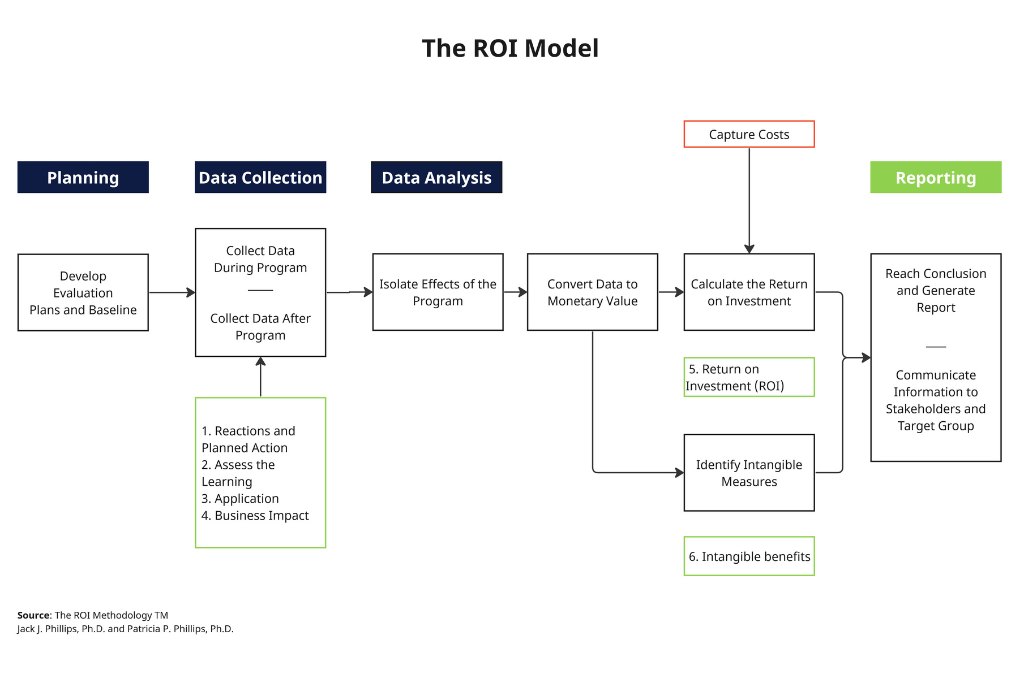Today I want to help you amplify your business growth by solving mission impossible.
We’re going to measure the return on investment (ROI) of your coaching.
Knowing how to measure the return for your clients is huge.
Being able to report that is crucial to the success of your coaching arrangement. Particularly for corporate clients as costs increase and expenditure grows.
So how do you capture ROI?
The answer lies in the collection of six types of data.
What is Return on Investment (ROI)
ROI measures the gain or loss relative to the amount of resources you’ve invested, such as time and money.
For coaches, understanding ROI isn’t about profitability. It’s about sustainability. Making informed decisions and optimising strategies for future growth.
For you it’s the bridge between your coaching passion and business acumen.
For your clients it answers, “Why should I continue working with you?”
Initial steps to calculate ROI
- Coaching leads to action.
- Action impacts the business.
- Impacts are quantified and measured
Start by establishing the goals and key objectives of your coaching agreement.
For coaching to add significant business value, it has to be based on the needs of the business.
With business goals established, coaching has the best opportunity to deliver actual ROI.
The ROI Methodology ™
Here’s a visual of the ROI Model

Source: The ROI Methodology ™
Jack J. Phillips, Ph.D. and Patricia P. Phillips, Ph.D.
Let’s break it down.
Planning and Data Collection: The Evaluation framework
The ROI model consists of six types of data collection.
1: Reactions and planned action
This data captures how your clients felt about the coaching process.
It measures their immediate reactions, satisfaction and perceived relevance.
Begin by gathering immediate feedback during and after each coaching session.
For example:
- Relevance of the coaching to current job
- Importance of coaching to job success
- Intent to apply insights from coaching
- Effectiveness of the coach
- Value of new insights from coaching
To gauge the initial reactions and satisfaction of your clients consider using:
- Surveys
- Feedback forms
- Direct conversations
This will help you understand the perceived value of your coaching sessions.
Key Metric: Client Satisfaction Score
2. Assess the learning
This type of data evaluates the knowledge, skills, and competencies gained from coaching.
Determine what knowledge or skills your clients have acquired during each coaching session.
Key Metric: Learning development rate
3. Application in real life
Here, the focus is on the application of new knowledge or skills.
Assess the changes in behaviour or action taken due to coaching.
- How are clients are applying their new skills and knowledge?
- How are they implementing strategies?
- What challenges are they overcoming more efficiently?
- What measurable impact is that creating?
Key Metric: Application Rate
4. Measure Business Impact
For executive coaching, the end game is often business results.
Track quantifiable metrics that showcase the business impact of the coaching sessions.
This could be:
- Increased productivity
- Higher quality
- Lower costs
- Time efficiencies
- Improved team dynamics
Key Metric: Change in Key Performance Indicators (KPIs)
5. Financial analysis – ROI
To calculate the ROI, you need to quantify the benefits and know total costs.
The benefits will come from the tangible improvements observed in step 4.
Translate those improvements into financial terms.
If productivity improves by 10%, what is the monetary value of increased productivity?
Key Metric: Monetary Value of Business Impact
6. Intangibles
These are benefits from the coaching process which aren’t easily financially quantified. Yet are significant.
Examples might include increased job satisfaction or personal growth.
Calculate the ROI:
To calculate the ROI ensure you have:
- Quantified the benefits of coaching
- Know the total costs of the coaching
You can then calculate ROI in two ways.
- The benefits/cost ratio (BCR)
This the monetary benefits of coaching divided by the coaching cost
BCR = Benefits
Cost
- The ROI %
The ROI % uses net benefits divided by cost.
The net benefits are the monetary benefits minus the costs:
ROI (%) = Net Benefits x 100
Costs
Let’s look at an example.
- Ten people get coaching, including all costs = £74,000
- The benefits of this project are £288,000.
This means that for every pound spent, you get 3.89 pounds in return (£288,000/£74,000).
For the ROI %
Take the benefit/cost ratio, subtract one (1), and multiply that result by 100 to get the ROI as a percentage.
e.g. benefit/cost ratio (3.89), subtract one (1), and multiply by 100 to get 289%.
ROI = 289%
Planning for ROI
Here it’s important to make two plans.
One to collect data and the other for analysing the data.
The plan for collecting data should state what types of information you need, when and how you will get it.
The analysis plan should focus on how the coaching affects money or costs in the business. It should also explain how to report the data.
Collecting data and information
The two easiest ways to do this are:
- Follow up questionnaire
- Interview – asking questions
The interview can be more flexible than the questionnaire but may take up more time.
The same set of questions can be used in both, but the interview offers more opportunities to probe.
Common mistakes to avoid
In measuring ROI, try and avoid falling into these pitfalls.
- Only take credit for the coaching impact: The best way to isolate the effects of coaching is to use your client’s estimates. Let them indicate % improvement linked to coaching and the measurable impact it generates.
- Validate estimates: After making an estimate, check it’s validity. To do this, rate how sure your client is of their estimate. Rate it from 0% (not sure at all) to 100% (very sure). Then multiply the rating by the estimate to get the final number.
- Converting to money: Turning data into money isn’t as hard as it seems. For example a monetary value may exist for certain things. For example staff turnover costs. This is called a standard value. Ask for existing examples of standard value or ask for expert input.
- Include all costs: When calculating the cost of coaching, include all costs. Fees, materials, time, travel, admin costs and evaluation. You also need to add in the time of both the coach and the person being coached.
Conclusion
Measuring ROI isn’t difficult.
But, it’s easier when you follow a step-by-step process for collecting and analysing data.
Remember, measuring ROI is a competitive advantage. It’s something which separates you from all the other coaches out there.
For clients, it could be the deciding factor in retaining your services.
And for you? It could be a catalyst for growing and differentiating your business.
TL;DR
- Ensure that the engagement focuses on a business need.
- You and your client are responsible for providing the data.
- Keep the process as simple and credible as possible.
- Follow the methodology.
- Communicate results.
- Use the data to iterate and improve.


